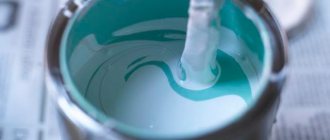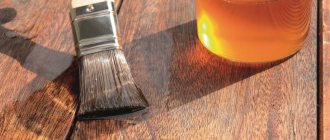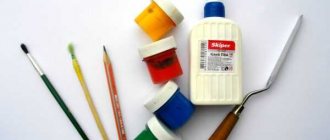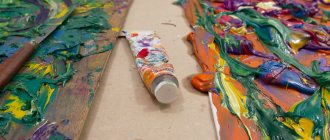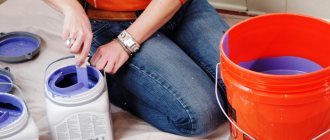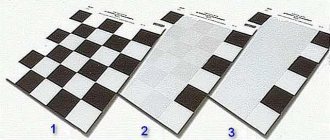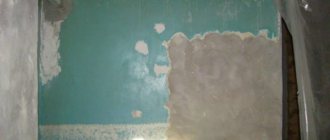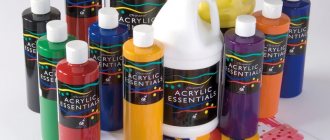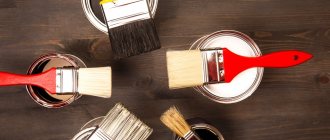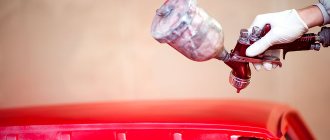How to thin acrylic emulsion paint?
Tap water is quite suitable for diluting water-based paint; it is advisable to just let it sit for a couple of hours. If the paint will be applied by spraying, use special thinners for water-based paints. These thinners can be purchased at any hardware store.
Interesting materials:
How to calibrate the sensor on Xiaomi? How to refuse free medications through government services? How to refuse hot water from Kievteploenergo? How to refuse MTS cable television? How to refuse a radio point through government services? How to refuse a radio point in an apartment in Moscow through government services? How to unsubscribe from MTS mailing list? How to refuse Tinkoff investments? How to recline in Sapsan? How to disable safe search in the new VK on iPhone 2020?
Problem with painting paint
Artists will try their best when it comes to their paint. We also tend to be, well, cheap. This leads us to brainstorm all kinds of ideas to fix problems with our materials. Trying to thicken acrylic paints is no exception.
For the humble artist, it might make sense to turn to a common household product that is known for making things thicker. Cornstarch and flour are two that often come to mind. After all, they do a fantastic job when you need to thicken a sauce, right?
While it is true that such things may seem creative, we must consider the long-term consequences. The main issue here is the impact on paint durability. These hacks may work today, but you want your painting to last for a very long time. Adding an unknown element will compromise the archival quality of your paint.
Additionally, you should also consider the performance of your paint with these non-traditional additives. Art paints are made with a specific formula, and, for acrylics, a part that determines how well it mixes with water.
Even though you are trying to thicken the paint, you may still need to thin it or add wash on top of it from time to time. Adding water to acrylic with cornstarch or flour can create a nasty, slimy paste that can be awkward to work with.
The third and final consideration is the negative impact on the paint color itself. Paintings like this can change shade - from red to pink, for example - and this can happen immediately when it dries, or at any time in the future.
Adviсe
If you choose the right solvent for the paint and varnish material, then after painting cracks will not appear, the layer will not swell, or the product will not curl. To remove paint residues, it is also important to choose a suitable composition, taking into account the characteristics of the base so as not to spoil it. To easily remove a dried layer, you need to make the right efforts, trying to rub the substance deeper so that it can saturate the layer and it will come off completely.
Most compounds are hazardous to humans, so working with them must follow safety rules. General rules include the following:
- The master puts on protective gloves, goggles, and a respirator;
- If the work takes place inside, and not on the road part, on the street, then high-quality ventilation of the room is created;
- If drops get on the mucous membranes, rinse with water immediately and consult a doctor for help.
If you choose the right solvent for the paint and varnish material, then after painting cracks will not appear, the layer will not swell, or the product will not curl.
The article described how to properly dilute paint so as not to lose its technical characteristics and not have to buy a new can. The choice of product is important; they focus on the constituent components of the coloring material. If it is necessary to remove a layer, do not forget about the type of base so as not to cause damage to it.
How to dilute with water
In its original form, acrylic paint has a thick consistency, so it needs to be diluted. For this, special solvents or products recommended by the manufacturer are used.
However, you can use a simple and affordable means for dilution - water. This component is initially included in the composition, so it does not disturb the texture and makes the consistency convenient for application.
It is important to understand that the proportion of water must be strictly observed so as not to spoil the original properties. In addition, for the intended purposes you will only need clean and cool water, without additional impurities.
In painting work, four types of dilution proportions are used:
- Ratio 1:1. If you add water in equal quantities to the volume of paint, you will get a consistency suitable for applying a base coat. The liquid will be thick, but will not stick to the roller or brush and will lie evenly over the surface.
- Ratio 1:2. If you add two parts of water to one part of paint, you get a composition of a mobile consistency, creating a thin layer on the surface to be painted. Used on smooth surfaces to reduce the intensity of dark colors.
- Ratio 1:5. If the amount of water added 5 times the volume of paint, a liquid composition is obtained - tinted water, which will penetrate between the fibers of the working tool. When applied, a barely noticeable layer is formed, which will look interesting when painting textured surfaces.
- Ratio 1:15. In this case, the result is ordinary water with a small amount of dissolved dye. This composition is used to create smooth transitions between shades and gradient color designs.
Measure the required amount of water with a syringe or measuring cup to maintain the recommended proportions.
Be careful: you need to dilute acrylic paint with small portions of water, adding gradually. In this case, you cannot stop stirring.
What to do if the paint has dried
It is impossible to accurately calculate the amount of material needed, so professional builders prefer to take it in reserve. After interior finishing, there are situations when some amount of paint remains unused.
The remainder in the jar gradually dries out - the moisture evaporates over time, and polymerization begins. The more liquid “leaves”, the lower the performance characteristics of the composition.
You shouldn’t immediately throw away the damaged material: you can try to revive the paint, returning it to its original properties.
Instructions for restoring dried paint.
- Grind the remains into powder with a minimum fraction.
- Pour boiling water over for 2-3 seconds , then drain.
- Repeat the procedure 2-3 times so that the composition warms up.
- Leave the boiling water in the jar and mix the contents thoroughly until smooth.
If the paint has turned into a homogeneous plastic lump, proceed as in the previous case. But at the final stage of resuscitation, add alcohol instead of hot water. Regular women's nail polish, added a little at a time, can also help.
If finances allow, buy acrylic thinner "Gamma" . It is inexpensive, but does an excellent job with paint that has acquired a “rubber” consistency. The product is sold in online stores and specialized retail outlets.
The performance properties of the restored material will be lower than the original ones - the lumps will not completely dissolve, which will negatively affect the strength of the coating. Use this composition for painting minor surfaces that are not noticeable.
If acrylic paint has deteriorated after improper storage, for example, at subzero temperatures, it cannot be restored. In such a situation, irreversible polymerization of the material begins, various substances will be powerless.
Thicken the paint
Alkyd enamel - PF-115 I bought several cans, it is very liquid. How can you thicken paint?
without deteriorating the properties of the paint - no way
. although, if you are going to plant tiles on the enamel, then you can add any construction powder there: chalk, cement, gypsum.
S35 wrote: Alkyd enamel - PF-115 I bought several cans, it is very liquid. How can you thicken paint?
volume of solvent To some extent, viscosity can be increased by lowering the temperature of the paint (refrigerator)
iale wrote: volume of solvent
Then it’s better to let it settle and drain the rising solvent.
Alexey B wrote: Then it’s better to let it settle and drain the rising solvent.
long wait. And the solvent is unlikely to separate from the base. I've never seen anything like this. Varnish or drying oil rises, yes, but I have never seen a solvent on top.
Alexey B wrote: Then it’s better to let it settle and drain the rising solvent.
This is unlikely, the pigment will settle, and the varnish and solvent will not separate
iale wrote: This is unlikely, the pigment will settle, and the varnish and solvent will not separate
Quite likely, but when I washed my brushes in one jar (many brushes and more than one day) and then left this jar on the balcony for a week, the solvent (white spirit) “floated”, that is, the paint settled. I then carefully poured the white spirit into another jar and threw away the sediment.
and if you freeze it. As I remember, when frozen, alkyds delaminate. the solvent will float up. Although I would go to the store and return them and buy another manufacturer.
Dispel wrote: although I would go to the store and return them and buy another manufacturer
We are not looking for easy ways
Alexey B wrote: I then carefully poured the white spirit into another jar and threw away the sediment.
so white spirit and so on. The ratio of plant/varnish/pigment is different.
iale wrote: the plant/varnish/pigment ratio is different.
2S35 For some reason it seems to me that your paint is good. If it covers well, why thicken it? Liquid paint is easier to work with and costs less. Poor quality paint is when you open a new jar and stir it for a long time until you lift the pigment from the bottom and mix it with the varnish. And if the paint you just bought has no sediment, it’s good paint.
When I was working with paint and varnish materials, I thickened alkyd paints with the addition of 1-2% talc. True, I’m not at all sure that after simply mixing talcum powder with paint there will be the same effect as after a ball mill
Acrylic - happiness for the artist
Acrylic is a wonderful invention for both artists and painting enthusiasts. Relatively inexpensive price, availability, rich color palette, harmlessness and virtual absence of toxic substances and pungent odors, all this makes this paint almost universal. If not for one “but”.
Acrylic paint is perfect for those who do not like to wait a long time, but want to immediately admire the finished result. As you know, acrylic is a quick-drying paint. But it is precisely this property that has a downside - the paint can dry right in the tube and you will have to buy a new one. How can this be avoided? How to revive dried acrylic paints?
By the way, how to avoid this, how to work with acrylic and all other points we discuss in detail in my course “Interior painting”
In this course we learn to paint beautiful paintings that fit perfectly into any interior. This is a very comprehensive course in which you will learn to work in modern acrylic painting techniques and with elements of picture decor.
After completing the course, you can save tens of thousands of rubles on gifts and home improvement by learning how to create expensive, atmospheric paintings that will decorate your entire home.
And perhaps not only yours. Since interior painting is currently the most profitable art form
